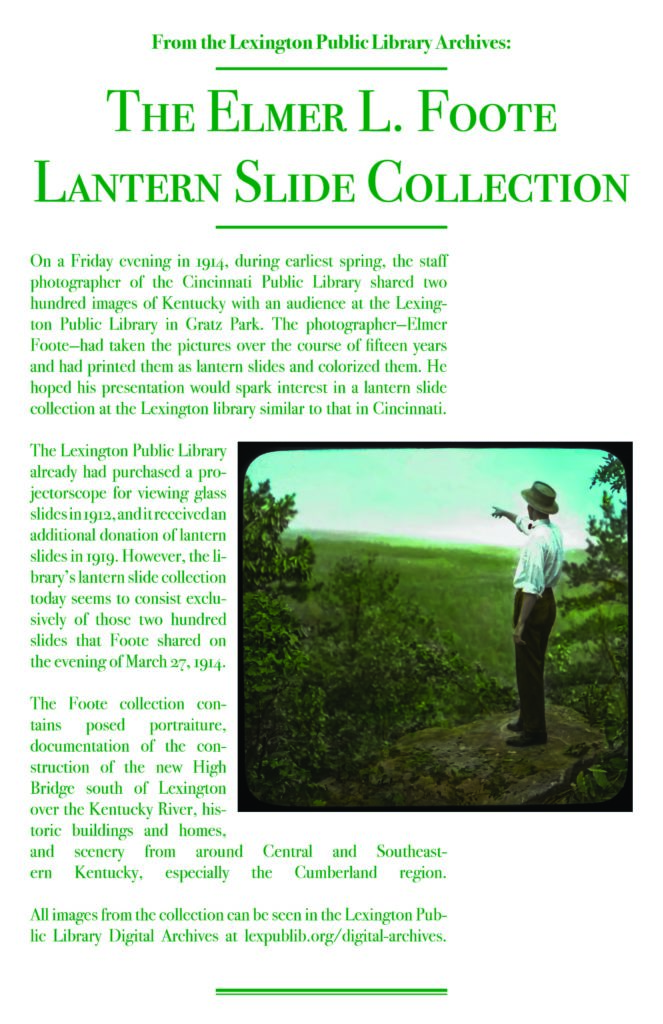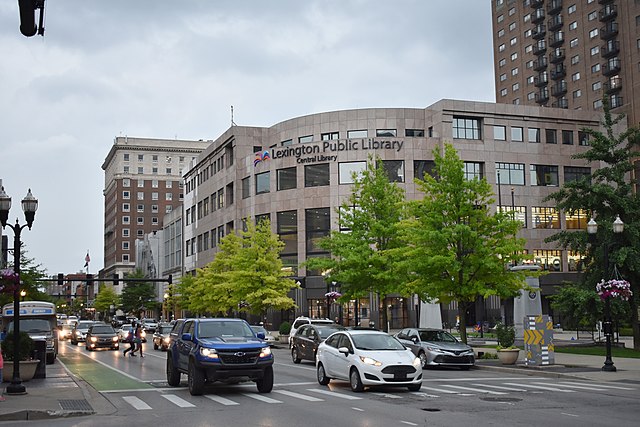The Urban Appalachian Community Coalition maintains an active role in research in the fields of Appalachian studies and Appalachian history. In addition to the Frank Foster Memorial Library, UACC sustains relationships with libraries throughout our region and beyond. An exciting resource is currently on display through the Lexington Public Library that provides a photographic window into an historical period in Appalachian and Kentucky history not often seen.
The Lexington Public Library is currently offering an exhibit of digitized lantern slides of the photographs of Elmer L. Foote. These are photographs taken in southeastern and central Kentucky before World War I. Elmer L. Foote was the official photographer of the Cincinnati Public Library from 1907 until his death in 1919. Foote’s photographs capture the people and places of rural Kentucky from a time many of us know little about. These images offer a rare glimpse of parts of Kentucky from before World War I.
Elmer L. Foote is about as unlikely a person you could imagine to end up being the official photographer for the Cincinnati Public Library. Born in Glastonbury, Connecticut, and transplanted to Cincinnati in 1888, Foote worked in the weaving industry for most of his adult life. He began working for the Cincinnati Public Library in 1907 at the circulation desk. However, his hobby was photography, and he soon made the transition to the official staff photographer for the library. During his time as staff photographer, Foote made numerous trips to central and eastern Kentucky to document the landscape, people, and culture. During this time, The Cincinnati Post wrote: “Foote knows many places in Kentucky. Several times a year he goes into the Kentucky mountains and finds Yellowstone Park scenery right at Cincinnati’s front doors step.” Indeed, the landscape, people, and culture of southeastern and central Kentucky remain at our doorstep, and the culture of this region gives life to the cultural life of greater Cincinnati.

Elmer L. Foote processed his photographs into glass lantern slides which are positive transparent photographs made on chemically treated glass plates. Foote’s photographs were hand-tinted with color. The Lexington Public Library acquired a lantern slide projector that made it possible to view Foote’s work. All that appears to be left of the lantern glass slides given to the Lexington Public Library consists of the photographs Foote took of southeastern and central Kentucky. Most of the former are centered on the Cumberland region. Even as the official photographer for the Cincinnati Public Library, Elmer L. Foote provided the State of Kentucky with some priceless historical artifacts.
Some of Elmer L. Foote’s photographs are in the digital collection of our current Cincinnati and Hamilton County Public Library. I spoke to Chris Smith at the History and Genealogy desk, and he provided a link to view the entire collection of historical photographs collected at the library. (You may select “foote, elmer l.” under “creator” if you wish to see only his photographs.) Smith, it turns out, is an urban Appalachian himself with family ties to West Virginia. The collection at the Cincinnati and Hamilton County Public Library contains 850 digitized glass lantern slides. Many of these images credit Elmer L. Foote as the photographer.
The display at the Lexington Public Library is available for travel free of charge, and I asked Smith if the Library of Cincinnati and Hamilton County would be interested. Smith explained that the downtown library is undergoing major renovations and will not be able to participate in public displays until 2024.
The digital exhibit of Elmer L. Foote’s glass lantern slides is on the Lexington Public Library website; once at the page click the green “Access Collection” button to view the collection. There are in all 200 images from the period. The slides are well worth the effort since they are a photographic record of a historical period not often seen in our time. For many of us, the window into pre-WWI Appalachian and central Kentucky comes through rare black and white images. Foote’s photographs, on the other hand, are extremely vivid. They give life to the people, the land, and even the ways of life that are at once distant and dear to many of us.
Much of Kentucky, including the Appalachian region in eastern Kentucky, went through massive changes from about 1930 to the present. The rapid industrialization that came with things like the WPA during the Great Depression changed these areas forever. It is rare that we can see a photographic record of what the people and the landscape looked like prior to this period of industrialization. For this reason, the glass lantern photographs by Elmer L. Foote are priceless. So much of the research conducted and supported by the Urban Appalachian Community Coalition depends on access to resources such these. You can view the digital exhibit of Elmer L. Foote’s glass lantern slides on the Lexington Public Library website at https://www.lexpublib.org/digital-archives/elmer-l-foote-lantern-slide-collection and clicking the green “access collection” button.
Mike Templeton is a writer, independent scholar, barista, cook, guitar player, and accidental jack-of-all-trades. Check out his profile in UACC’s new Cultural Directory. He lives in downtown Cincinnati with his wife who is a talented photographer. They spend their free time walking around the city snapping photos. She looks up at that the grandeur of the city, while Mike always seems to be staring at the ground.
Cover photo credit: Wikimedia Commons/Tamanoeconomico

